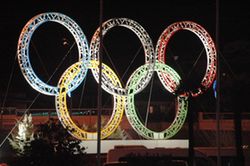Sochi (pps) Olympic Games have their own laws. Compared to World Championships of the International Luge Federation (FIL) and events of the Viessmann Luge World Cup series, the medals in the women’s and men’s singles at Olympic Games will not be awarded after two but after four competition runs. In the Olympic doubles events there are two competition runs, similar to FIL Championships and the Viessmann Luge World Cup.
The composition of the seeded groups is different at Olympic Games, too. In the women’s and men’s singles, there are three groups of 12 lugers (group A, group B, group C and a remaining group). The current positions in the seeded groups result from the World Cup standings of the three previous World Cup events (list of seeded athletes). According to the International Luge Regulations (IRO) these three events have to be on three different tracks and in at least two different nations.
With regard to the upcoming Winter Games in Sochi, the following Viessman Luge World events were decisive: Oberhof and Altenberg (both in Germany) as well as Sigulda (Latvia). The start order in the women’s and men’s as well as the doubles events in group A are determined by draw. And only group A (start order 1 to 12) is set up by name. The start order of the other groups B, C and remaining group is determined according to the World Cup standings.
The start order in the four women’s and men’s singles competition runs
First competition run: start number 1 to 12 (A), start number 13 to 24 (B), start number 25 to 36 (C), start number 37 to the last. – Second competition run: start number 12 to 1 (A), start number 24 to 13 (B), start number 36 to 25 (C) and last start number to 37. – The start order in the third competition run is determined by the race standings after two competition runs with the first to the last place. – The start position in the fourth competition run is in reversed order – that means that the first-ranked athlete after three competition runs will be the last to compete. Additionally, there will be a track preparation prior to the last 15 lugers.
The start order within the respective seeded groups in the doubles events is equally determined by draw. The first competition runs from start number 1 to 12, then from start number 13 until the last team. In the second and decisive competition run, the fastest team of the first run will be the last – similar to the women’s and men’s singles – to compete.
The medals in the Olympic Team Relay event will be awarded after one competition run, just as at FIL Championships. Contrary to World Cup events, however, there are seeded groups at FIL Championships and now at the Olympic première of the Team Relay. The five best teams according to the Nations ranking will be in the first seeded group. Within this group the five last start numbers are determined by draw.
The nation ranking is composed of the results of the best ranked athlete in the men’s and women’s singles as well as the doubles event (through the Viessmann Luge World Cup final in Sigulda, Latvia). Accordingly, the five top teams are Germany, Italy, Canada, Austria and the U.S.A. The remaining nations, as of start number six, compete in the reversed order of the Nations ranking, e.g. the national squad with the least number of points is the first team to compete in the Olympic Team Relay event. The five seeded teams – in their order determined by draw - are the last to start.









